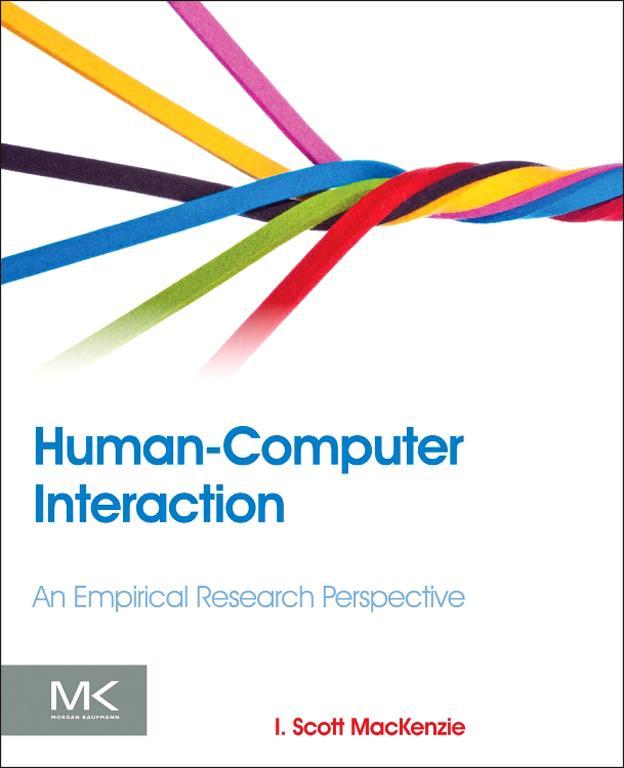I. Scott MacKenzie
Copyright
Acquiring Editor: Meg Dunkerley
Development Editor: Heather Scherer
Project Manager: Mohanambal Natarajan
Designer: Greg Harris
Morgan Kaufmann is an imprint of Elsevier
225 Wyman Street, Waltham, MA 02451, USA
Copyright 2013 Elsevier Inc. All rights reserved
No part of this publication may be reproduced or transmitted in any form or by any means, electronic or mechanical, including photocopying, recording, or any information storage and retrieval system, without permission in writing from the publisher. Details on how to seek permission, further information about the Publishers permissions policies and our arrangements with organizations such as the Copyright Clearance Center and the Copyright Licensing Agency, can be found at our website: www.elsevier.com/permissions
This book and the individual contributions contained in it are protected under copyright by the Publisher (other than as may be noted herein).
Notices
Knowledge and best practice in this field are constantly changing. As new research and experience broaden our understanding, changes in research methods or professional practices, may become necessary. Practitioners and researchers must always rely on their own experience and knowledge in evaluating and using any information or methods described herein. In using such information or methods they should be mindful of their own safety and the safety of others, including parties for whom they have a professional responsibility.
To the fullest extent of the law, neither the Publisher nor the authors, contributors, or editors, assumeany liability for any injury and/or damage to persons or property as a matter of products liability, negligence or otherwise, or from any use or operation of any methods, products, instructions, or ideas contained in the material herein.
Library of Congress Cataloging-in-Publication Data
Application submitted
British Library Cataloguing-in-Publication Data
A catalogue record for this book is available from the British Library
ISBN: 978-0-12-405865-1
For information on all Morgan Kaufmann publications visit our website at www.mkp.com
Printed and bound in USA
13 14 15 16 17 10 9 8 7 6 5 4 3 2 1

Preface
A few months ago, my son approached me with a problem. It was November, daylight saving time had arrived, and his watch was an hour fast. He was having trouble adjusting the time. Could I help? Sure, I said. He gave me the watch. By most standards, I am an expert in user interfaces. Modern watches have many features and just a few buttons. They have modes. I understand modes. Repeatedly press one button to cycle through the modes. Press and hold another button and the device is ready for change. That sort of thing. It might take some trial and error, but the task seemed simple enough. I was wrong. Try as I may, the watch resisted. I couldnt change the time! I borrowed the watch and brought it to work. At the time I was teaching a course called Advanced Human-Computer Interaction. The students, all MSc or PhD candidates, are more tech-savvy than their instructor. After all, these students were born in the digital age. Technology to them is like food or air. They consume it! I explained the situation and then gave the watch to the closest student. A few minutes later the watch was passed to the next student, then the next. About 30 minutes later, the watch was returned to me. The time was unchanged. Not a single student was able to change the time.
I am thankful for stories like this. They give you and me something to dosomething to think about and work on. Human-computer interaction (HCI) as a field of research and practice extends back 30 years. Despite the accomplishments, we still confront technology that utterly perplexes and frustrates us. Yes, there is work to do.
This book is not about designing a better watch. Of course, the end game is better designs and products, but the focus here is on the ideasideas for new and improved user interfaces or interaction techniques. The journey from idea to product is long, however. Before embedding in a product, an idea must be implemented, refined, tested, refined again, tested again, and so on. Testing is key: Is the idea any good? How good? Does it improve on current practice? According to what criteria and by how much? Will users like it? Is it intuitive, efficient, even fun, or will users find it awkward or frustrating? This book is about answering questions like these.
The questions above are expressions of curiosity. They capture the true and unstructured spirit of innovative thought. But answering these questions is a challenge. Terms like any good and improve on are highly subjective. To answer with clarity and assurance, the questions must be recast and narrowedto make them answerable, so to speak. Well-formed questions about new ideas for user interfaces invite observation and measurement of human interaction with the technology of interest. In the narrowed form, the questions are research questions. Furthermore, questions that are pursued through observation and measurement are empirical. With this, we arrive at this books theme: human-computer interaction, with an empirical research perspective.
This books study of empirical research in HCI is admittedly narrow. The reader is implored not to view this as dismissive of research methods in HCI that are also empirical but with a qualitative or non-experimental emphasis. HCI is a tremendously broad field with a considerable amount of empirical research, particularly in the social sciences, that uses observational methods as opposed to experimental methods. The emphasis on experimental methods in the pages ahead is a by-product of the books single-author design. To expand the treatment of observational methods here, giving them equal page space with experimental methods, would be a disservice to the substantial community of researchers skilled in these methods. This book reflects one researchers perspective and that perspective has more to do with the authors personal experience and expertise than with any suggestion that certain methods are superior to others. For this reason, the empirical research label is delegated to the books subtitle, or secondary title. Bracketing empirical research with perspective and the indefinite article an is deliberate. The book presents one perspective on empirical research in HCI. Often, the focus is broad (What is empirical? What is research?); but when laying down the details, there is an emphasis on research that is empirical and experimental. If there is one deliverable in this book, it is the knowledge and skills required to design and conduct a user studya factorial experiment with human participants where two or more facets of a user interface are empirically and quantitatively compared.
This book is organized into eight chapters. It begins with a historical context of the field in with tips and discussions on writing and publishing a research paper.











